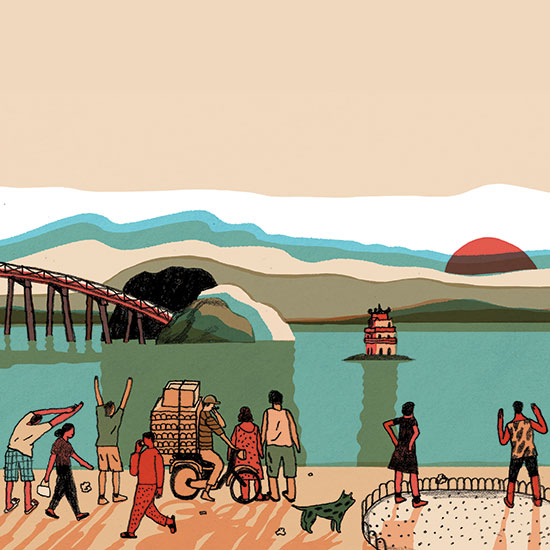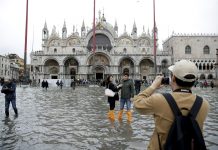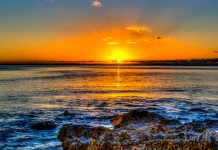This post may contain affiliate links. We may earn money or products from the highlighted keywords or companies or banners mentioned in this post.
11.21.14

Most people will tell you that sunset is the optimal time to visit Humayun’s Tomb, the red-sandstone-and-white-marble mausoleum in Delhi that inspired the Taj Mahal. (To my eyes it’s even more beautiful than its successor.) Me, I’m partial to sunrise. In this otherwise chaotic city, it’s one of the rare peaceful times to explore its acres of Persian-style gardens planted with mango and lemon trees.
Wandering the grounds one morning, enjoying the quiet while nibbling from a pack of shortbread cookies I’d grabbed from my mini-bar, I had the place to myself. Birdsong mingled with the whistles of distant trains and the aroma of jasmine, cut grass, and, from somewhere in the city, burning plastic. (This was still Delhi, after all.) Across the treetops, a brown sun peeked over a hazy brown horizon. Behind the mausoleum I passed the only other human on the premises: a groundskeeper trimming hedges with a scythe. He nodded at me and smiled. At that moment, from high in a banyan tree, two dozen macaque monkeys started to shriek and screech. En masse, they began dropping from the branches, floating to the ground like paratroopers—and suddenly a band of simian zombies was rushing straight at me. In no time, five or six were on my shoulders, swiping at my arms and tugging at my hair.
“The bees-cuits!!” the groundskeeper cried from across the lawn. “Throwww the beees-cuits!!”
It took me a second to recognize the Britishism, then I let fly the cookies, shot-putting them into a fountain. The troop scrambled off in pursuit, setting upon their prize in a flurry of wet fur and fingernails. It was just past 6 a.m., and I was as awake as I’d ever been.
I am not a morning person. I am a lover of evenings and midnights, firmly oriented to the post meridiem. (It took me some time to realize there was a 6 “a.m.”) On the road, however, I make a point of waking early. Just as safari guides have you up at dawn to catch the day’s prime activity, the world rewards those who rise before the sun.
Jet lag often makes this imperative, as do crazy-early flight arrivals. I remember landing at Heathrow on a Sunday morning with my parents at age 13, only to learn our B&B wouldn’t take us till noon; we wandered London’s vacant streets for hours, searching in vain for an open restaurant. (Picture 28 Days Later, but with Samsonite roll-aboards.)
But there are good reasons to hit the town before sunrise. Mornings are when a place is most specifically itself—before it’s properly dressed or put together, unaware that anyone’s watching when it steps out for the paper in a bathrobe. Like waking in a stranger’s bed, there’s a disarming intimacy to seeing a place in the pale light of dawn.
Things are different just an hour or two later. Under the day’s full glare, a foreign place can appear too foreign, too harsh, too much. But in morning’s gauzy half-light, hard edges soften, and the most overwhelming metropolis achieves a certain gentleness, before the heat and the clamor roll in.
Some of my favorite travel memories are from 4 or 5 a.m.’s around the world, badly immortalized in hundreds of grainy, inchoate photographs. (It’s almost impossible to capture that particular, primordial light with a camera: in this case, you really do need to be there.)
I remember, for instance, a predawn walk on the beach in Trancoso, Brazil: earth and sky and surf drained of color, hermit crabs scarcely bothering to move at my approach. Last night’s phosphorescence sparkled faintly on the sand. The world felt like a carnival ride that had yet to be turned on. I remember returning from a late night out in Paris, crossing the Pont Neuf as the sky went purple to pink. Off the Rue de Seine I passed the open door of a still-closed boulangerie, out of which came an intoxicating smell of butter and yeast. Someone had left a rack of warm baguettes in the doorway to cool in the crisp morning air. There was no one else in sight. I stood there for 17 seconds before realizing what had to be done. It was the best baguette I’d ever tasted.
But mostly I remember mornings in Asia, where dawn’s transformational power feels most profound. It helps that the time zones are a half-day off from home, such that nocturnals like me are wide awake at daybreak—right in sync with the city itself. In Asia, morninglife feels like nightlife. It’s not just street sweepers and saffron-robed monks; there’s a whole parallel morning economy at work.
Follow my lead, roust yourself from your Tokyo hotel bed at 4 a.m., and you’ll see what frenzied activity goes down before the sun is up. Your taxi will glide down empty expressways as if you’re in rural Nebraska, not a city of 13 million. On the sidewalks of Ginza, stray revelers are staggering home from their revelries. One girl is dressed as Snow White. You’ll start to wonder if you’re actually awake.
Finally, you’ll pull up at the Tsukiji Fish Market, amid a madcap ballet of forklifts. They careen at you full tilt, then swerve at the last possible moment. Everyone is wide awake, smoking, and wearing rubber boots—except you. You are wearing an ill-advised pair of loafers, which in a few hours will be summarily tossed in your hotel trash bin, the reek of fish guts so pervasive that no amount of free shoe-shining could possibly remove it.
You make your way inside to the famous tuna auction. From a corner you watch the action unfold, and in your transpacific delirium you’re convinced you understand what’s going on. Men with poles are poking a lifeless 500-pound tuna while smoking and shouting at each other. This could get ugly quick. You escape out a side door. Moments later you’re at Sushi Dai, a workaday joint beside the market, sipping ice-cold Sapporo while queuing for a counter seat. Soon you’re properly and irretrievably drunk, at 6:15 a.m. on a Tuesday, gorging on botan ebi and sake as if it were Friday night.
Back at your hotel, the newspaper’s not even on the doorknob yet.
But my all-time favorite morning ritual is a walk around Hoan Kiem Lake in Hanoi, which, on winter mornings, drapes itself in a lacy veil of mist. Willows dip their branches in the jade-green water. A red-lacquered wooden footbridge leads from the shore to a small island temple, where tendrils of incense rise to meet low-hanging clouds. The bridge is called the Huc, or “place of morning sunlight,” although it is usually shrouded in fog, such that as you cross you feel you’re stepping into nothingness.
A recent visit was no different. I rose at dawn to make a few circuits round the lake. As always, a cluster of elderly Vietnamese women were silently practicing tai chi on the grassy banks. Farther along, a rowdier group had assembled, flash-mob-style, to perform what we used to call “calisthenics.” One can chart the globalization of Hanoi life by the soundtrack: in the 90’s it was lilting Vietnamese folk tunes; now it’s “Single Ladies.” Back then, the women wore traditional pajamas; today they wear yoga pants or counterfeit tracksuits emblazoned juicey culture. After swiveling hips en masse, they circled up to form a 40-car massage train.
In the park, four boys dressed in blue-and-white school uniforms laughed over a game of badminton. The sidewalk pho vendor was already serving breakfast; early-shift workers crouched over steaming bowls of broth. The odd Hanoians who still ride bikes—there are a few—were visible at this hour, before the motorbikes and SUV’s scared them back into hiding. The jingle of old bicycle bells is the sweetest sound you can imagine.
After my pho and another lap around the lake, the sun finally broke through the mist, and the heat of the day settled in. When it got too hot I returned to my hotel to take refuge in the lobby AC. But by now the pho vendor’s hearty broth had made me sleepy, like it often does. So I climbed upstairs and slipped back into bed, with the sights and sounds of the morning still jostling in my head, and I dreamed of incense and shuttlecocks and bicycles and bridges to clouds.
Peter Jon Lindberg is T+L’s editor-at-large.
Illustrated by Josh Cohran
Also on Travel + Leisure:
Meet Our Local Experts
Food as a Jet Lag Cure
Air Travel Tips
Powered by WPeMatico











